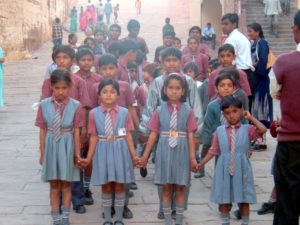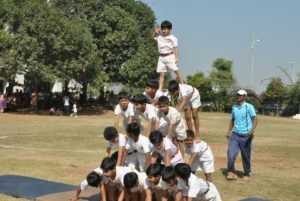Why is India still one of the developing countries and what is stopping it from being a developed one? This particular question strikes me every time when I read something about India’s education system. I see India’s education system as an obstacle towards its objectives of achieving inclusive growth.
The Indian Education system: Overview

Our country India has always been famous for gaining education since the Vedic period. In ancient times, India had the Guru Kula system of education in which anyone who wished to study went to a teacher’s (Guru) house and requested to be taught. If accepted as a student, the guru allows the student to stay at his place and help in all activities at home. This not only created a strong tie between the teacher and the student but also taught the student everything about running a house. The guru teaches the student everything that he wants to learn, from Sanskrit to the Holy Scriptures and from Mathematics to Metaphysics. The student stayed as long as he wished or until the guru felt that he had taught everything he could teach. All of the learning was closely linked to nature and to life, and not just confined to memorizing some information.
Until the 17th century, India was considered one of the richest country in the world. However, due to the arrival of the foreign colonizers and the wrong policies of the then rulers, India lost almost all its richness wealth wise as well as knowledge-wise. Originally, Lord Thomas Babington Macaulay brought the modern school system to India, including the English language, in the 1830s. The educational program was restricted to the so-called modern subjects such as science and mathematics, and subjects like metaphysics and philosophy were considered unnecessary. The teaching was confined only to classrooms and the link with nature and the close relationship between the teacher and the student was broken.
The modern education system has been supported by one formula: ‘cheap, required and customary education to all’. Even people are able to decide by their conscience that what means of education are going to be best suited to them. Still, many people are ignoramus regarding words and literacy. Therefore, they are within the necessity to urge a correct education. It is required to supply education to all, as other nations are so much ahead within the field of education. It is all in the hand of the government that what ought to be the exact type of system in which education for all is secured. Moreover, even the government has taken nice measures to extend the level of education.
The main features of the modern education system in India are as follows:
- A system of obligatory education to all or any children up to the year of fourteen. Under this age, all children must be given education in any government or private school.
- If any child is forced to do any other job excluding from being educated the person concerned in such activities will be treated as per law.
- After gaining primary education, a child can be given secondary education.
- For providing this level of education each, the central and state governments are involved through their boards, which are created for this purpose.
- There are also private boards who conduct a high school or intermediate exams.
- After their 10+2 (secondary schooling), a person can pursue bachelor, master and an alternative specialization degree in several fields of their selection.
The above points appear to be simple but there are any flaws in this system as well.
Advantages and Disadvantages of Indian Education system

Advantages of Indian education
With the advancement of education, India has seen an excellent development within the field of economy. People are less unemployed and some of them are even freelancing or rather self-employed. One of the best positive things is that child labor has gone down to an excellent extent. There are also reservation systems available for the socially underprivileged people. The present statistics is 7.5% of the scheduled tribes, 15% for the scheduled castes and 27% of the other backward class, but the exact percentages vary from state to state. In Haryana, the reservation is 18% for SCs and 1% for OBCs and 0% for STs, based on local demographics. In Tamil Nadu, the reservation is 18% for SCs and 1% for STs, based on local demographics.
Presently there are chiefly two boards with the exception of the state boards conveying education until higher secondary, that is, ICSE and CBSE. In addition to this, there are also Open Universities providing study at home facility. If you crosscheck the technical fields, there are several institutions providing higher education. Additionally, you will find some institution providing the facility of e-Tutorial.
Disadvantages of Indian education
The major downside of the prevailing system of education is that it is not easily affordable. Nowadays in India, more than 37% of people are living below the poverty level. Therefore, they cannot afford education even at the primary level.
Another reason for the poor quality of education is the poor quality of teachers in government schools. The level of education that government schools are not as expected and they do not possess an honest image among people. The ensuing possibility is the private institutions, which provides degrees from private to postgraduate. However, they are very costly an also the admission procedure is too complicated for common person to access.
The best part of Indian Education system was and is in its ‘Rote Learning’- Kanthastha, as it was in ancient India. This stimulates the mind, body, soul. Improves concentration and bursts the stress. Invokes inner sense. In the CBSE system, with continuous analysis and understanding of theory concept, the student is bound to do well in life. However, the annual system can be a boon for slow and average learners. The understanding of various subjects and equal weight to all is another excellent way to give horizontal knowledge. There is a combination of logic and ability, thereby, giving equal importance to the left and right brains. It is such a holistic educational system.
Moreover, there are several political heads, which form a great gap between the Indian government and the common people. A number of them take money from the government, however, do not utilize for the great of the common people. In addition, one will find several socially forward individuals taking the benefits of the reservation system. The problem lies within the massive percentage of illiteracy and population. These two things need to be focused much on creating any development.
Steps to improve the current system:
Following steps should be taken to enhance and boost the current education system and convey it in everyone’s reach:
- The government ought to take steps to extend the number of primary schools in order that people of each village can get education easily.
- There ought to be more emphasis given on adult education as it is necessary to teach the parents and guardians first in order that they become keen towards there ward’s education.
- The role of the private institutions ought to be made restricted and so that people do not depend too much on them. In this way, they will not be taking a high amount of fees as they want.
- The condition of the government colleges and institution ought to be raised to a reasonable level.
- New syllabus ought to replace the old ones so as to provide the latest knowledge to students.
- Education loans ought to be made available easily so that even poor students can afford a high level of education.
- There ought to be strict laws relating to the cheating and coaching mafias.
- In addition, the system of education ought to be created free of corruption.
- Everyone ought to be given equal opportunity without discriminating on the premise of rich and poor or on the premise of gender.
- Especially girl’s education ought to be given topmost priority.
Conclusion:
The conclusion that we are able to draw is that even within the modern time, India can be given back it is standing of a wealthy knowledge full land, choked with ethics and moral beauty. In short, India is a progressing country and the present scenario of Indian education can be improved a lot. The sole step to be taken is to boost ourselves and there is a necessity of strict laws to appreciate the good ones and to penalize the wrong ones regardless of what the field is. The solution lies in the question. How to improve the system of education? And the answer is “Education”. The sole way to improve education is education.
by Pragyan
We believe in sharing knowledge with everyone and making a positive change in society through our work and contributions. If you are interested in joining us, please check our ‘About’ page for more information
